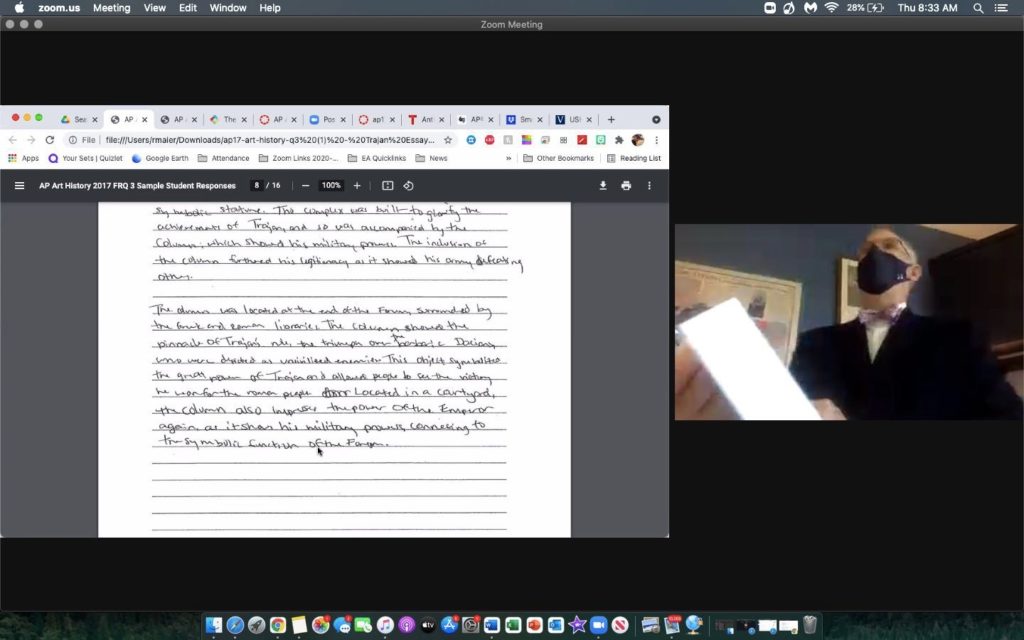Kathryn Barber ‘23
Elizabeth Boruff ‘23
EA sickness protocols have been significantly altered from last year, and the community has mixed opinions on the changes. These adjustments include stricter policies around joining class virtually and going home due to illnesses, as well as differences in the rules regarding close contacts and their vaccination statuses.
Previously, parents and students were able to opt-in to either in-person or virtual school either for the entirety of the year or periodically at their discretion. If a student felt they were beginning to show signs of having COVID-19, to keep other students safe, they could decide to attend virtually until they became well again.

Photo courtesy of Miguel Peña ’22
This policy, however, led to many students abusing the online option for non-medical absences, leading to EA’s choice to implement stricter rules regarding the zoom-in option. Stefania Calastri ‘23 says, “A lot of kids think that zoom school is more relaxed, so they’ll just decide to stay home even if they have barely any signs of sickness or if they just want to. It sort of divided our grade a lot last year because there were a lot of kids on zoom and then a lot of kids in class, and it just felt weird.”
This year, students can only Zoom into school if they have contracted COVID-19 or will be absent for a prolonged period due to a medical issue. Michael Letts, Head of the Upper School, asserts, “We only allow zooming or virtual access in cases that are related to COVID. Cases have to be cleared through Laura Hurst [Director of Health Services] and will be allowed only in situations where that student is quarantined or isolated because we mandate it. That’s the only time that we would do that.”
Letts adds that another circumstance in which online school is an option is when “we have very unique and unfortunate medical circumstances, where a student can’t make it to campus but will be out for an extended period of time that extends beyond a full week. And in those cases, the same applies. Parents would have to give that medical information to Mrs. Hurst and then she would be the one to say yes this child should be granted virtual access classes because of this medical condition.”
Students feel both positively and negatively about the new zoom policy. Calastri supports the change, saying, “Obviously, if it’s for a long time, a student should be able to zoom, so they don’t miss all their work, but if it’s just for a couple of days, I think it’s manageable to catch up on work for that.”
However, other students believe that the new policy leads to a significant loss of education. Ishan Bhattacharyya ‘23 comments, “I missed a lot of classes, and I had about three tests the week when I was sick. I wasn’t adequately prepared for my tests because I missed classes all week, and if we were able to zoom in, I think I would have been able to retain the information and be more prepared for my tests.”
Now that students can no longer zoom-in for common illnesses, they must decide whether they are well enough to attend or should stay home and miss classes. In addition, before students return, they must determine whether or not they may have contracted COVID-19. As a result, Hurst has developed specific guidelines, following the direction of local and state health departments and the CDC, to help keep the community safe.
Hurst details what steps to take if a student feels sick, saying, “If a student is not feeling well, they should stay home. Students are encouraged to contact their physician for further evaluation and guidance regarding testing. If needed, testing can be performed at EA.” EA offers free COVID-19 testing to students and faculty that are experiencing its symptoms or who were in close-contact with someone who tested positive for COVID-19. Nikhil Walling ‘22 didn’t know that these tests were still being offered until recently, saying, “I had heard about them starting the program back at the beginning of the school year but haven’t heard any updates about it since then. It’s good that they’re offering the service but I think it could be more effective if they spread the word more.”
Like last year, if an individual tests positive, they must be isolated for ten days. Prior to returning to in-person school, they must have improving symptoms and be fever free for 24 hours without the use of fever-reducing medication.
A close-contact’s vaccination status determines how long that individual must quarantine. Hurst comments, “Unvaccinated close-contacts must be quarantined for seven days and test negative on day five, six, or seven prior to returning to in-person learning. Vaccinated close-contacts are not required to quarantine but must test negative three to five days post exposure.”
In September, the Girls’ Water Polo Team experienced a COVID-19 outbreak, causing them to experience these newly installed procedures. Grace Julian ‘23 explains how the week after their tournament, “a few people tested positive and our practice was canceled for the week. We all then got tested on Tuesday and Thursday and if you were positive you were sent home. For everyone that tested negative twice, we returned to practice the following week.” When asked about her opinion on their requirements, Julians says, “I’m happy that we did all this just so we could all be safe and keep the school safe. It’s nice that the school offered testing for us.”